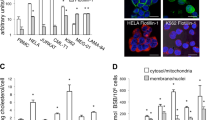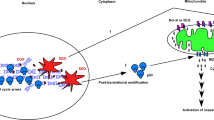Abstract
In the present study, we investigated the in vitro apoptotic response of leukemic cells to the cellular stress induced by homoharringtonine (HHT), a plant alkaloid with antileukemic activity which is currently being tested for treatment of acute and chronic leukemias. A comparison of leukemic cell lines with different p53 gene status revealed a considerably higher sensitivity to HHT-induced apoptosis in the cells with a wt p53, and apoptotic events in wt p53 leukemia cells (MOLT-3 cell line) were studied in more detail. To this end, we examined components of apoptotic cascades including Bax expression and its intracellular localization, changes of mitochondrial membrane potential (MMP), reactive oxygen species (ROS) levels, cytochrome c release from mitochondria and activation of caspases. Bax protein levels did not increase despite an up-regulation of bax at mRNA level. However, Bax translocation from cytosol towards mitochondria was observed. In addition, we observed a release of cytochrome c from the mitochondria, and the localization changes of both Bax and cytochrome c were found already at the early, annexin V-negative stage of HHT-induced apoptosis. HHT-treated MOLT-3 cells revealed loss of MMP as well as activation of caspases demonstrated by DEVD-, IETD- and LEHD-tetrapeptide cleavage activity in the cell lysates. ROS levels only slightly increased in HHT-treated cells and antioxidants did not prevent apoptosis and MMP changes. Therefore, wt p53 leukemic cells respond to HHT-specific cellular stress by induction of ROS-independent apoptotic pathway characterized by translocation of Bax, mitochondrial cytochrome c release and activation of caspases.
This is a preview of subscription content, access via your institution
Access options
Subscribe to this journal
Receive 12 print issues and online access
$259.00 per year
only $21.58 per issue
Buy this article
- Purchase on Springer Link
- Instant access to full article PDF
Prices may be subject to local taxes which are calculated during checkout









Similar content being viewed by others
References
Chao DT, Korsmeyer SJ . BCL-2 family: regulators of cell death Annu Rev Immunol 1998 16: 395–419
Gross A, McDonnell JM, Korsmeyer SJ . BCL-2 family members and the mitochondria in apoptosis Genes Dev 1999 13: 1899–1911
Mates JM, Sanchez Jimenez FM . Role of reactive oxygen species in apoptosis: implications for cancer therapy Int J Biochem Cell Biol 2000 32: 157–170
Nunez G, Benedict MA, Hu Y, Inohara N . Caspases: the proteases of the apoptotic pathway Oncogene 1998 17: 3237–3245
Fadeel B, Orrenius S, Zhivotovsky B . The most unkindest cut of all: on the multiple roles of mammalian caspases Leukemia 2000 14: 1514–1525
Kornblau SM . The role of apoptosis in the pathogenesis, prognosis, and therapy of hematologic malignancies Leukemia 1998 12: S41–46
O'Brien S, Kantarjian H, Keating M, Beran M, Koller C, Robertson LE, Hester J, Rios MB, Andreeff M, Talpaz M . Homoharringtonine therapy induces responses in patients with chronic myelogenous leukemia in late chronic phase Blood 1995 86: 3322–3326
O'Brien S, Kantarjian H, Koller C, Feldman E, Beran M, Andreeff M, Giralt S, Cheson B, Keating M, Freireich E, Rios MB, Talpaz M . Sequential homoharringtonine and interferon-alpha in the treatment of early chronic phase chronic myelogenous leukemia Blood 1999 93: 4149–4153
Feldman EJ, Seiter KP, Ahmed T, Baskind P, Arlin ZA . Homoharringtonine in patients with myelodysplastic syndrome (MDS) and MDS evolving to acute myeloid leukemia Leukemia 1996 10: 40–42
Feldman E, Arlin Z, Ahmed T, Mittelman A, Puccio C, Chun H, Cook P, Baskind P . Homoharringtonine is safe and effective for patients with acute myelogenous leukemia Leukemia 1992 6: 1185–1188
Tujebajeva RM, Graifer DM, Karpova GG, Ajtkhozhina NA . Alkaloid homoharringtonine inhibits polypeptide chain elongation on human ribosomes on the step of peptide bond formation FEBS Lett 1989 257: 254–256
Zhou DC, Zittoun R, Marie JP . Homoharringtonine: an effective new natural product in cancer chemotherapy Bull Cancer 1995 82: 987–995
Chou TC, Schmid FA, Feinberg A, Philips FS, Han J . Uptake, initial effects, and chemotherapeutic efficacy of harringtonine in murine leukemic cells sensitive and resistant to vincristine and other chemotherapeutic agents Cancer Res 1983 43: 3074–3079
Fresno M, Jimenez A, Vazquez D . Inhibition of translation in eukaryotic systems by harringtonine Eur J Biochem 1977 72: 323–330
Visani G, Russo D, Ottaviani E, Tosi P, Damiani D, Michelutti A, Manfroi S, Baccarani M, Tura S . Effects of homoharringtonine alone and in combination with alpha interferon and cytosine arabinoside on ‘in vitro’ growth and induction of apoptosis in chronic myeloid leukemia and normal hematopoietic progenitors Leukemia 1997 11: 624–628
Fenaux P, Jonveaux P, Quiquandon I, Preudhomme C, Lai JL, Vanrumbeke M, Loucheux Lefebvre MH, Bauters F, Berger R, Kerckaert JP . Mutations of the p53 gene in B-cell lymphoblastic acute leukemia: a report on 60 cases Leukemia 1992 6: 42–46
Wada M, Bartram CR, Nakamura H, Hachiya M, Chen DL, Borenstein J, Miller CW, Ludwig L, Hansen Hagge TE, Ludwig WD, et al. Analysis of p53 mutations in a large series of lymphoid hematologic malignancies of childhood Blood 1993 82: 3163–3169
Jonveaux P, Berger R . Infrequent mutations in the P53 gene in primary human T cell acute lymphoblastic leukemia Leukemia 1991 5: 839–840
Karawajew L, Ruppert V, Wuchter C, Kosser A, Schrappe M, Dorken B, Ludwig WD . Inhibition of in vitro spontaneous apoptosis by IL-7 correlates with Bcl-2 up-regulation, cortical/mature immunophenotype, and better early cytoreduction of childhood T-cell acute lymphoblastic leukemia Blood 2000 96: 297–306
Bonsing BA, Corver WE, Gorsira MC, van Vliet M, Oud PS, Cornelisse CJ, Fleuren GJ . Specificity of seven monoclonal antibodies against p53 evaluated with Western blotting, immunohistochemistry, confocal laser scanning microscopy, and flow cytometry Cytometry 1997 28: 11–24
Kastan MB, Onyekwere O, Sidransky D, Vogelstein B, Craig RW . Participation of p53 protein in the cellular response to DNA damage Cancer Res 1991 51: 6304–6311
Blagosklonny MV . Loss of function and p53 protein stabilization Oncogene 1997 15: 1889–1893
An WG, Kanekal M, Simon MC, Maltepe E, Blagosklonny MV, Neckers LM . Stabilization of wild-type p53 by hypoxia-inducible factor 1alpha Nature 1998 392: 405–408
Matsumoto H, Shimura M, Omatsu T, Okaichi K, Majima H, Ohnishi T . p53 proteins accumulated by heat stress associate with heat shock proteins Hsp72/Hsc73 in human glioblastoma cell lines Cancer Lett 1994 87: 39–46
Sala A, Casella I, Grasso L, Bellon T, Reed JC, Miyashita T, Peschle C . Apoptotic response to oncogenic stimuli: cooperative and antagonistic interactions between c-myb and the growth suppressor p53 Cancer Res 1996 56: 1991–1996
Linke SP, Clarkin KC, Di Leonardo A, Tsou A, Wahl GM . A reversible, p53-dependent G0/G1 cell cycle arrest induced by ribonucleotide depletion in the absence of detectable DNA damage Genes Dev 1996 10: 934–947
Ljungman M, Zhang F, Chen F, Rainbow AJ, McKay BC . Inhibition of RNA polymerase II as a trigger for the p53 response Oncogene 1999 18: 583–592
An WG, Chuman Y, Fojo T, Blagosklonny MV . Inhibitors of transcription, proteasome inhibitors, and DNA-damaging drugs differentially affect feedback of p53 degradation Exp Cell Res 1998 244: 54–60
Miyashita T, Reed JC . Tumor suppressor p53 is a direct transcriptional activator of the human bax gene Cell 1995 80: 293–299
Sheikh MS, Fornace AJ Jr . Death and decoy receptors and p53-mediated apoptosis Leukemia 2000 14: 1509–1513
Friesen C, Fulda S, Debatin KM . Cytotoxic drugs and the CD95 pathway Leukemia 1999 13: 1854–1858
Attardi LD, Reczek EE, Cosmas C, Demicco EG, McCurrach ME, Lowe SW, Jacks T . PERP, an apoptosis-associated target of p53, is a novel member of the PMP-22/gas3 family Genes Dev 2000 14: 704–718
Oda E, Ohki R, Murasawa H, Nemoto J, Shibue T, Yamashita T, Tokino T, Taniguchi T, Tanaka N . Noxa, a BH3-only member of the Bcl-2 family and candidate mediator of p53-induced apoptosis Science 2000 288: 1053–1058
Johnson TM, Yu ZX, Ferrans VJ, Lowenstein RA, Finkel T . Reactive oxygen species are downstream mediators of p53-dependent apoptosis Proc Natl Acad Sci USA 1996 93: 11848–11852
Caelles C, Helmberg A, Karin M . p53-dependent apoptosis in the absence of transcriptional activation of p53-target genes Nature 1994 370: 220–223
Haupt Y, Rowan S, Shaulian E, Kazaz A, Vousden K, Oren M . p53 mediated apoptosis in HeLa cells: transcription dependent and independent mechanisms Leukemia 1997 11: (Suppl. 3) 337–339
Polyak K, Xia Y, Zweier JL, Kinzler KW, Vogelstein B . A model for p53-induced apoptosis Nature 1997 389: 300–305
Li PF, Dietz R, von Harsdorf R . p53 regulates mitochondrial membrane potential through reactive oxygen species and induces cytochrome c-independent apoptosis blocked by Bcl-2 EMBO J 1999 18: 6027–6036
Schuler M, Bossy Wetzel E, Goldstein JC, Fitzgerald P, Green DR . p53 induces apoptosis by caspase activation through mitochondrial cytochrome c release J Biol Chem 2000 275: 7337–7342
Selvakumaran M, Lin HK, Miyashita T, Wang HG, Krajewski S, Reed JC, Hoffman B, Liebermann D . Immediate early up-regulation of bax expression by p53 but not TGF beta 1: a paradigm for distinct apoptotic pathways Oncogene 1994 9: 1791–1798
Hsu YT, Wolter KG, Youle RJ . Cytosol-to-membrane redistribution of Bax and Bcl-X(L) during apoptosis Proc Natl Acad Sci USA 1997 94: 3668–3672
Wolter KG, Hsu YT, Smith CL, Nechushtan A, Xi XG, Youle RJ . Movement of Bax from the cytosol to mitochondria during apoptosis J Cell Biol 1997 139: 1281–1292
Gross A, Jockel J, Wei MC, Korsmeyer SJ . Enforced dimerization of BAX results in its translocation, mitochondrial dysfunction and apoptosis EMBO J 1998 17: 3878–3885
Jurgensmeier JM, Xie Z, Deveraux Q, Ellerby L, Bredesen D, Reed JC . Bax directly induces release of cytochrome c from isolated mitochondria Proc Natl Acad Sci USA 1998 95: 4997–5002
Kluck RM, Bossy Wetzel E, Green DR, Newmeyer DD . The release of cytochrome c from mitochondria: a primary site for Bcl-2 regulation of apoptosis Science 1997 275: 1132–1136
Zamzami N, Marchetti P, Castedo M, Decaudin D, Macho A, Hirsch T, Susin SA, Petit PX, Mignotte B, Kroemer G . Sequential reduction of mitochondrial transmembrane potential and generation of reactive oxygen species in early programmed cell death J Exp Med 1995 182: 367–377
Thornberry NA, Rano TA, Peterson EP, Rasper DM, Timkey T, Garcia Calvo M, Houtzager VM, Nordstrom PA, Roy S, Vaillancourt JP, Chapman KT, Nicholson DW . A combinatorial approach defines specificities of members of the caspase family and granzyme B. Functional relationships established for key mediators of apoptosis J Biol Chem 1997 272: 17907–17911
Nicholson DW, Thornberry NA . Caspases: killer proteases Trends Biochem Sci 1997 22: 299–306
Acknowledgements
We are grateful to Grit Czerwony and Rosemarie Hoffmann for valuable technical assistance. This work was supported by grants from the Deutsche Leukämie-Forschungshilfe (DLFH-98.04, to VR), from the Deutsche Jose Carreras Leukämie-Stiftung (DJCLS-98/NAT-3, to CW), and from the China Scholarship Council (to ZC).
Author information
Authors and Affiliations
Rights and permissions
About this article
Cite this article
Cai, Z., Lin, M., Wuchter, C. et al. Apoptotic response to homoharringtonine in human wt p53 leukemic cells is independent of reactive oxygen species generation and implicates Bax translocation, mitochondrial cytochrome c release and caspase activation. Leukemia 15, 567–574 (2001). https://doi.org/10.1038/sj.leu.2402067
Received:
Accepted:
Published:
Issue Date:
DOI: https://doi.org/10.1038/sj.leu.2402067
Keywords
This article is cited by
-
Complexation with C60 Fullerene Increases Doxorubicin Efficiency against Leukemic Cells In Vitro
Nanoscale Research Letters (2019)
-
Pharmacokinetics and excretion of 14C-omacetaxine in patients with advanced solid tumors
Investigational New Drugs (2016)
-
Sulfonoquinovosyl diacylglyceride selectively targets acute lymphoblastic leukemia cells and exerts potent anti-leukemic effects in vivo
Scientific Reports (2015)
-
Evidence for microRNA-31 dependent Bim-Bax interaction preceding mitochondrial Bax translocation during radiation-induced apoptosis
Scientific Reports (2015)
-
Pharmacokinetic study of omacetaxine mepesuccinate administered subcutaneously to patients with advanced solid and hematologic tumors
Cancer Chemotherapy and Pharmacology (2013)



